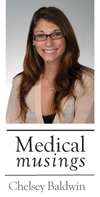|
|
|

|
After one semester, med student finds new ‘normal’
|
Editor’s Note:
Chelsey Baldwin of Little River is a first-year medical student. This
column follows the journey of her class in becoming doctors.
 The start of
the semester, I found myself stirring at 4:30 a.m. clumsily stumbling
around the dimly-lit world until the brisk weather of that January
morning abruptly brought me to my senses. Release of epinephrine acting
on the alpha receptor, causation of increased alertness. The start of
the semester, I found myself stirring at 4:30 a.m. clumsily stumbling
around the dimly-lit world until the brisk weather of that January
morning abruptly brought me to my senses. Release of epinephrine acting
on the alpha receptor, causation of increased alertness.
I made my way to ART’s (Ashley River Tower) fourth floor, main OR
lobby. I had come to shadow an anesthesiologist in an attempt to
rejuvenate the excitement that is dampened by stacks of note cards and
dauntingly thick syllabi. By the time I had made it into the building
my toes were numb, my absolute least favorite part of winter. Arteriovenuous
anastomosis, mechanism for shunting blood to the vital
organs to maintain core temperature.
One of my professors, Dr. Jake Abernathy, placed me in a bay with an
elderly woman receiving an epidural from Dr. Tara Queener, an
anesthesiology and perioperative medicine resident. It was explained
out loud that Dr. Queener would recognize the “right spot” had been hit
when the plunger of the needle easily descended into the patient’s
body. I wracked my brain with what this could mean while watching the
hunched-over patient, who was seemingly wondering the same thing. Epidural space,
site at which spinal nerves can be accessed to block
sensation and pain to a given dermatome.
Being there, with Dr. Queener and her patient, was a great opportunity
to piece together the knowledge derived from hours in the library and
attempt to apply them to something that I was observing. There is no
greater moment for a medical school student than glorious opportunities
to spout off the awesome intricacies of the body that we have been
forced to learn in excruciating detail, let alone to a receptive
audience. This isn’t always the case. It’s an adjustment to realize
that what you find amazing not only doesn’t translate to amusement for
others, but also at times can lead even to the opposite. For instance,
my best friend from undergraduate school and I used to find amusement
in all the same things. Verbal filtering has become quite necessary for
“appropriate” conversation between us. No matter how fascinating my
explanation of lactose intolerance symptoms may be and despite the
seemingly thrilling tales I have to tell about the trials and
tribulations within the dissection lab, I have had to accept that this
will never be welcomed dinner conversation between us.
Apparently I am not the only one who has an evident disconnect with the
normal and appropriate. My lab partner, the very lovely and dedicated
Aisha Jackson, explained to me just the other day how every now and
then our altered concept of the norm is all too apparent. “Is it odd
that I eat cereal while reading Rohen?” she said, referring to a
dissection guide that uses images of actual cadavers. “Sometimes I
think something isn’t quite right here.” We shrug and acknowledge the
possible oddness of the situation.
But as it were, my decision to do shadowing was good timing and fun to
make use of the various morsels of information that streamlined through
my thoughts as Dr. Queener worked to place a catheter in the epidural
space. In fact, it was a good change of pace from the bewildering
feelings of “I don’t know anything” that typically accompanies my
interactions with real patients, and I found it exciting to have a
chance to pick the brains of those who do. Hence, when left alone with
Dr. Queener, I couldn’t help but spout off a stream of various
questions about the procedure taking place before me. What will they do
with that node? What does that number mean over there? Why do you need
that other tube? The list could go on and, luckily for me, Dr.
Queener
was more than a good sport and answered my plethora of questions. She
even filled me in on her life as a resident.
I asked the typical questions: how long her residency program would
take to complete, how many hours she works each week and what she
enjoys about the job? After hearing horror stories about residency, I
was rather pleased to hear her say, “I have time to read.” I thought
about it for a minute and remembered the book I had started over
Christmas break that now just sits on my bed stand, not touched since
my return to school.
“Did you have time to read in medical school too?” I asked her.
“ … Oh, no” Dr. Queener replied.
A wave of relief came over me. “Okay… just making sure.
Friday, Jan. 28, 2011
|
|
|



 The start of
the semester, I found myself stirring at 4:30 a.m. clumsily stumbling
around the dimly-lit world until the brisk weather of that January
morning abruptly brought me to my senses.
The start of
the semester, I found myself stirring at 4:30 a.m. clumsily stumbling
around the dimly-lit world until the brisk weather of that January
morning abruptly brought me to my senses.